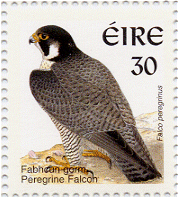
Peregrine Falcon( Fabhcún Gorm) 32p
 The
Peregrine Falcon is one of the most common bird's of prey in Ireland.
The
Peregrine Falcon is one of the most common bird's of prey in Ireland.
It can be found on
all continents except Antartica. In spite of this, many populations have decreased at an
alarming rate sometimes close to extinction (that is gone all together, as in no more
left).
This is due again to the use of sprays and chemicals by farmers on the land, poisoning the food chain So when they have nothing to eat , they die.
This is how it happens -: if a farmer puts out rat poison on his land or around his farm and a rat eats it, the poison goes into the rats stomach and usually kills him, eventually. Along comes the Peregrine Falcon or some other bird of prey and swoops down and grabs the rat. When the falcon then eats the rat, he also eats the poison, which the rat has in its body. The poison is then transferred to the bird's stomach and will probably kill the Falcon as well. In Ireland the numbers of Peregrine Falcons had dropped to only 25 --30 breeding pairs in 1970, but due to educating the farmers in pest control their numbers are on the increase again. Some of the chemicals which farmers also used have been banned to see if the numbers would increase, happily they have.
The male is slate grey above whitish barred with black below. there are also black markings around its face and white cheeks. The female is a larger bird , with similar colouring. Young birds are browner above and streaked below not barred. They swoop down from the sky at speeds of up to 160Km/h. and more. It is like a nose dive with their wings closed., the prey being killed instantly by the speed of the attack and the claws of the bird.
The breed on cliff edges in remote areas, away from man. Despite the difficulty of reaching their nests, they are still attacked by egg collectors and falconers, who steal young birds to rear in captivity.
The stamp was issued in Phase 2 on August 27th. 1997.
Written by --:Gary Walsh